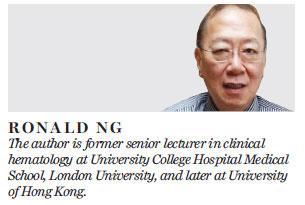HK must encourage innovation
Updated: 2015-11-05 09:25
By Ronald Ng(HK Edition)
|
|||||||||
Ronald Ng says Hong Kong can learn from the Singapore government's fine example by creating an environment that fosters research and development
The 2015 Global Innovation Index (GII) report came as a surprise to some people in Hong Kong. Both Hong Kong and Singapore were among the top 10 most innovative countries/territories in 2012, 2013 and 2014, but the report for 2015 showed Hong Kong has dropped out of the top 10 list. It is now in 11th place, with Singapore being the only Asian jurisdiction on that list, and thereby being NO 1 in Asia. Is this a cause for alarm for Hong Kong?
The GII is the simple average of two sub-indices: the Innovation Input Sub-index and the Innovation Output Sub-Index. The former index is a measure of how much a society has put in to enhance innovation. The Output Sub-index is a measure of the innovative output. Singapore ranked NO 1 in the world Innovation Input Sub-index, while Hong Kong came in at fourth place. On the Innovation Output Sub-Index, Singapore ranked 20th and Hong Kong actually beat Singapore at 19th. For obvious reasons, in terms of actual economic contribution, the innovation output is of more immediate benefit. For comparison, the United Kingdom ranked sixth on the Innovation Input Sub-Index, lower than both Hong Kong and Singapore, but it ranked ninth in the Innovation Output Sub-Index. This clearly shows that the two might not be that closely correlated.
What are the parameters that are measured which go into the composition of the Innovation Input Sub-index? It measures parameters such as institutional strength, human capital, research, education, infrastructure, sophistication of the market and sophistication of the business practices. Could it be that the input index is a leading indicator? Countries such as the United States, the UK and other mature European economies have had a head start in innovation, and places such as Hong Kong and Singapore are playing catch-up with them. After all, what society puts in place today - for example funds for research and development - will not bear fruit until many years later. If this hypothesis is true, then what the government of Singapore is doing is of immense significance. Perhaps, Hong Kong could emulate some of the relevant practices.
A study of the fate of startups - defined as companies which have been in existence for less than five years - has shown that 44 percent failed because of poor revenue, which probably means their products or services were not wanted in the market (this is called "poor product-market fit"), 17 percent because they ran out of cash, meaning they did not manage their cash flow properly, and 31 percent because they did not even get started. The rest closed down because of partnership disputes. Rounding these numbers up, it means 61 percent failed because of lack of entrepreneurial skill.
Some governments have tried to give grants to startups to spur them along. Another study in Singapore showed that even after stringent selection, of those startups that received roughly $50,000 in grants only between 2 and 8 percent of them were subsequently successful enough to go on and receive a second round of funding. Of those companies that received some form of mentorship, 20 percent to 36 percent were successful enough to go for second-round funding.
Based on these findings, Singapore has now instituted what are known as "accelerators". These are private companies funded by venture capitalists with some government funding participation in the form of equity ownership. The accelerators look for companies which have a valuation of around $280,000 to $500,000 and take a position in those that look promising, taking up a 6 percent to 9 percent stake in them. Mentorship is then provided to these companies, guiding them how to run things. The companies are supposed to "graduate" after three months. Follow-up studies showed that 62 percent to 87 percent then went on and managed to get second-round funding. Contrast this with the results prior to the institution of the accelerators program, when only between 2 and 8 percent were successful enough to go on and receive a second round of funding.
These programs are private concerns, but they are encouraged and facilitated by the government. The government has a clear vision of providing the proper ecology for innovation and startups to take root and flourish. It is up to the private sector to take advantage of this eco-environment. As mentioned, the accelerator program started only in 2014 and the full flowering or result of that program might take a few years. But it is already showing promise.
As also mentioned, one of the inputs GII uses in its calculation of the ranking is education. The recent slide of University of Hong Kong down the rankings and the rise of National University of Singapore and Nanyang Technological University no doubt have contributed to the difference in GII ranking of the two territories.
Perhaps this contrast between Hong Kong and Singapore on the GII ranking and the Singapore government's proactive stance on creating an environment to foster research and development should result in some urgency for resuming the debate on the establishment of the Innovation and Technology Bureau in Hong Kong.

(HK Edition 11/05/2015 page9)